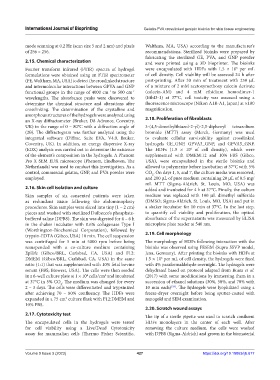Page 435 - IJB-9-3
P. 435
International Journal of Bioprinting Gelatin-PVA crosslinked genipin bioinks for skin tissue engineering
mode scanning at 0.2 Hz (scan size 5 and 2 nm) and pixels Waltham, MA, USA) according to the manufacturer’s
of 256 × 256. recommendations. Sterilized bioinks were prepared by
fabricating the sterilized GE, PVA, and GNP powder
2.15. Chemical characterization and were printed using a 3D bioprinter. The bioinks
6
Fourier transform infrared (FTIR) spectra of hydrogel were encapsulated with HDFs with 1.5 × 10 per mL
formulations were obtained using an FTIR spectrometer of cell density. Cell viability will be assessed 24 h after
(PE, Waltham, MA, USA) to detect the crosslinked structure post-printing. After 30 min of treatment with 250 µL
and intermolecular interactions between GPVA and GNP of a mixture of 2 mM acetoxymethoxy calcein derivate
functional groups in the range of 4000 cm to 500 cm (calcein-AM) and 4 mM ethidium homodimer-1
-1
-1
wavelengths. The absorbance peaks were discovered to (EthD-1) at 37°C, cell toxicity was assessed using a
determine the chemical structure and alterations after fluorescence microscope (Nikon A1R-A1, Japan) at ×100
crosslinking. The determination of the crystalline and magnification.
amorphous structures of the hydrogels were analyzed using
an X-ray diffractometer (Bruker, D8 Advance, Coventry, 2.18. Proliferation of fibroblasts
UK) in the range of 0 – 80°C with a diffraction angle of 3-(4,5-dimethylthiazol-2-yl)-2,5-diphenyl tetrazolium
(2θ). The diffractogram was further analyzed using the bromide (MTT) assay (Merck, Germany) was used
integrated software (Diffrac. Suite EVA, V4.0, Bruker, to evaluate cellular survivability against crosslinked
Coventry, UK). In addition, an energy dispersive X-ray hydrogels GE_GNP, GPVA3_GNP, and GPVA5_GNP.
(EDX) analysis was carried out to determine the existence The HDFs (1.5 × 10 of cell density), which were
6
of the element’s composition in the hydrogels. A Phenom supplemented with DMEM:12 and 10% FBS (Gibco,
Pro X SEM EDX microscope (Phenom, Eindhoven, The USA), were encapsulated in the sterile bioinks and
Netherlands) was used to conduct this investigation. As a allowed to polymerize before incubation at 37°C with 5%
control, commercial gelatin, GNP, and PVA powder were CO . On days 1, 5, and 7, the culture media was removed,
2
employed. and 200 µL of pure medium containing 20 µL of 0.5 mg/
mL MTT (Sigma-Aldrich, St. Louis, MO, USA) was
2.16. Skin cell isolation and culture added and incubated for 4 h at 37°C. Finally, the culture
Skin samples of six consented patients were taken medium was replaced with 100 µL dimethyl sulfoxide
as redundant tissue following the abdominoplasty (DMSO; Sigma-Aldrich, St. Louis, MO, USA) and put in
procedures. Skin samples were sliced into tiny (1 – 2 cm) a shaker incubator for 10 min at 37°C. In the last step,
pieces and washed with sterilized Dulbecco’s phosphate- to quantify cell viability and proliferation, the optical
buffered saline (DPBS). The skin was digested for 4 – 6 h absorbance of the supernatants was measured by ELISA
in the shaker incubator with 0.6% collagenase Type I microplate plate reader at 540 nm.
(Worthington-Biochemical Corporation), followed by
trypsin-EDTA (Gibco, USA) 10 min. The cell suspension 2.19. Cell morphology
was centrifuged for 5 min at 5000 rpm before being The morphology of HDFs following interaction with the
resuspended with a co-culture medium containing bioinks was observed using FESEM (Supra 55VP model,
Epilife (Gibco/BRL, Carlsbad, CA, USA) and F12: Jena, Germany). After printing the bioinks with HDFs at
DMEM (Gibco/BRL, Carlsbad, CA, USA) in the same 1.5 × 10 per mL of cell density, the hydrogels were fixed
6
ratio (1:1) that was supplemented with 10% fetal bovine with 4% paraformaldehyde overnight. The hydrogels were
serum (FBS; Biowest, USA). The cells were then seeded dehydrated based on protocol adapted from Busra et al.
in a 6-well culture plate at 1 × 10 cells/cm and incubated (2017) with some modifications by immersing them in a
2
4
at 37°C in 5% CO . The medium was changed for every succession of ethanol solutions (30%, 50%, and 70% with
2
2 – 3 days. The cells were differentiated and trypsinized 10 min each) . The hydrogels were lyophilized using a
[29]
after achieving 70 – 80% confluency. The HDFs were freeze-dryer overnight before being sputter-coated with
expanded in a 75 cm culture flask with F12:DMEM and nanogold and SEM examination.
2
10% FBS.
2.20. Scratch wound assays
2.17. Cytotoxicity test The tip of a sterile pipette was used to scratch confluent
The encapsulated cells in the hydrogels were tested HDFs monolayers in the center of each well. After
for cell viability using a Live/Dead Cytotoxicity removing the culture medium, the cells were washed
assay for mammalian cells (Thermo Fisher Scientific, with DPBS (Sigma-Aldrich) and grown in the biomaterial
Volume 9 Issue 3 (2023) 427 https://doi.org/10.18063/ijb.677

